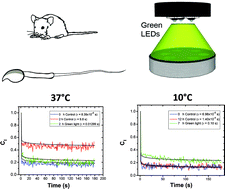The effect of green light on the motility of mouse sperm at two different temperatures
Abstract
Photo-modulation with visible light has been used to induce gains in the motility of the sperms of rabbits, boars, buffalo, bulls, fish, and humans. Although different hypotheses have been proposed to explain such an effect, the origin and mechanisms by which visible light affects sperm motility are still far from being completely understood. Several groups have observed changes in the intracellular Ca2+ concentration and significant differences in the production of ROS, which are attributed to specific photosensitizers. Also, it has been reported that blue light induces nitric oxide production in sperm cells, which plays a vital role in acrosome reaction and capacitation leading to an augmentation in the fertilisation probability. In the present work, we study the effects of green light (490–540 nm) on the sperm motility of mice. Firstly, we carried out experiments at 37 °C to confirm what previous researchers have observed before using red and blue light: that the overall sperm motility increases. Secondly, we studied the effects of green light at 10 °C and found that the motility drastically diminishes. In order to understand this opposing outcome, we carried out fluorescence measurements to evaluate reactive oxygen species production induced by green light at both temperatures. Our results suggest that the balance between the use and generation of ROS at 37 °C is favorable to the cells, while at 10 °C it is harmful.



 Please wait while we load your content...
Please wait while we load your content...